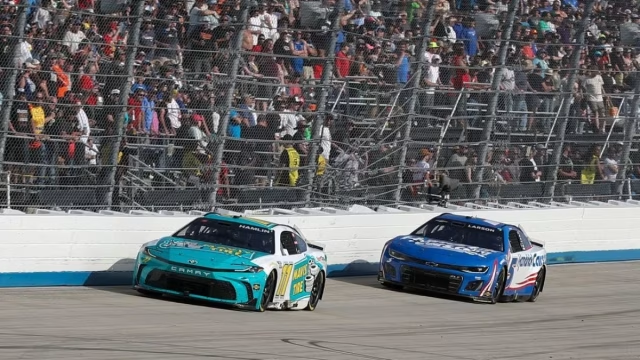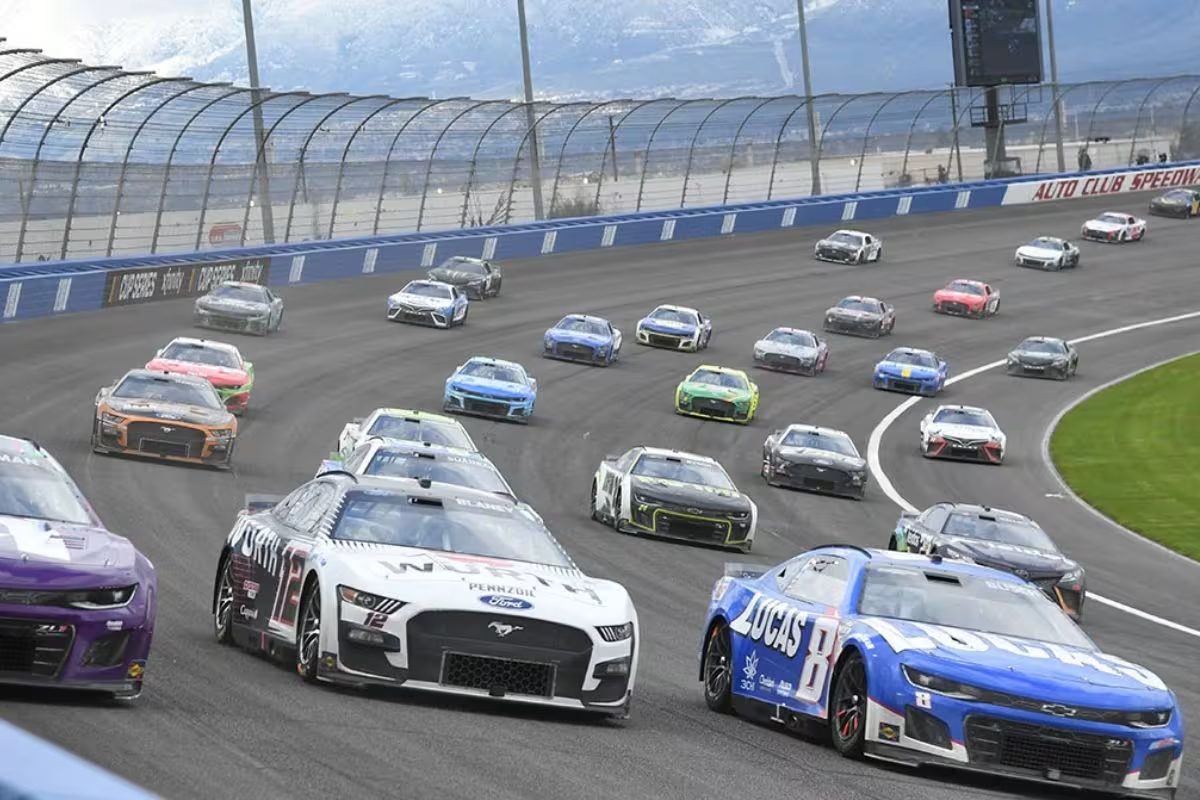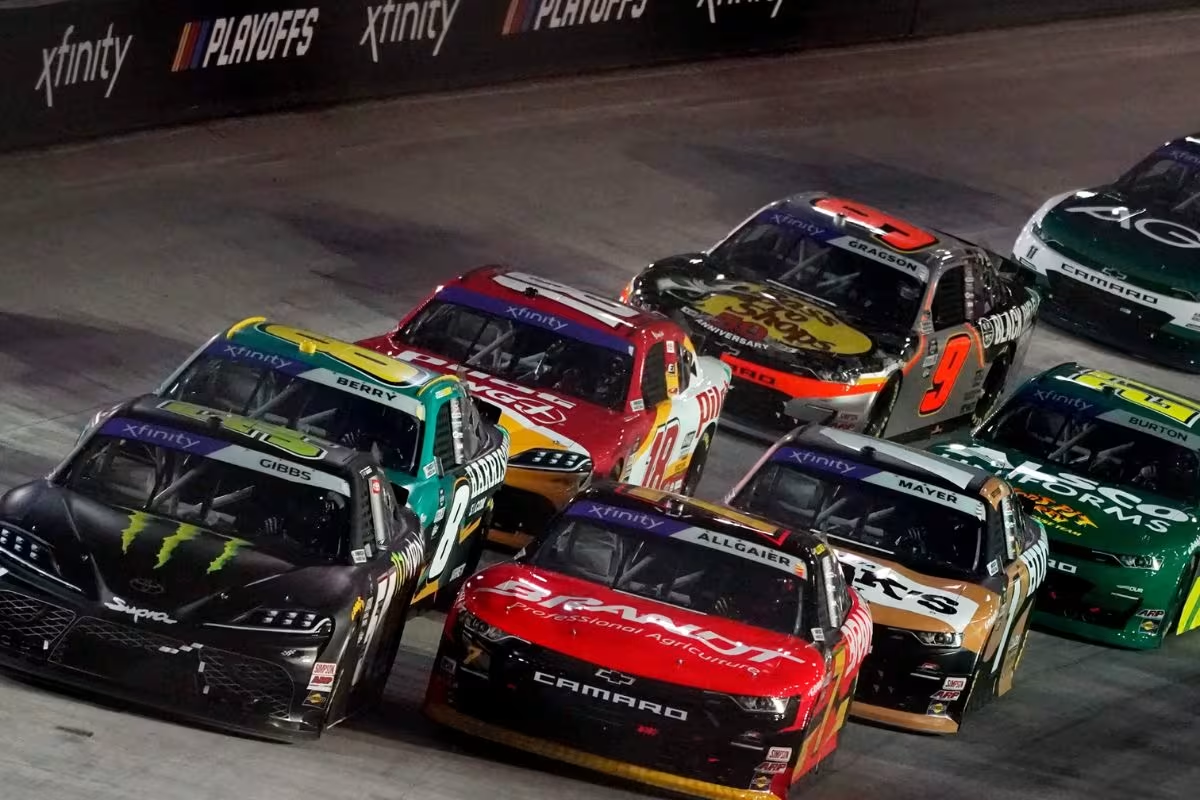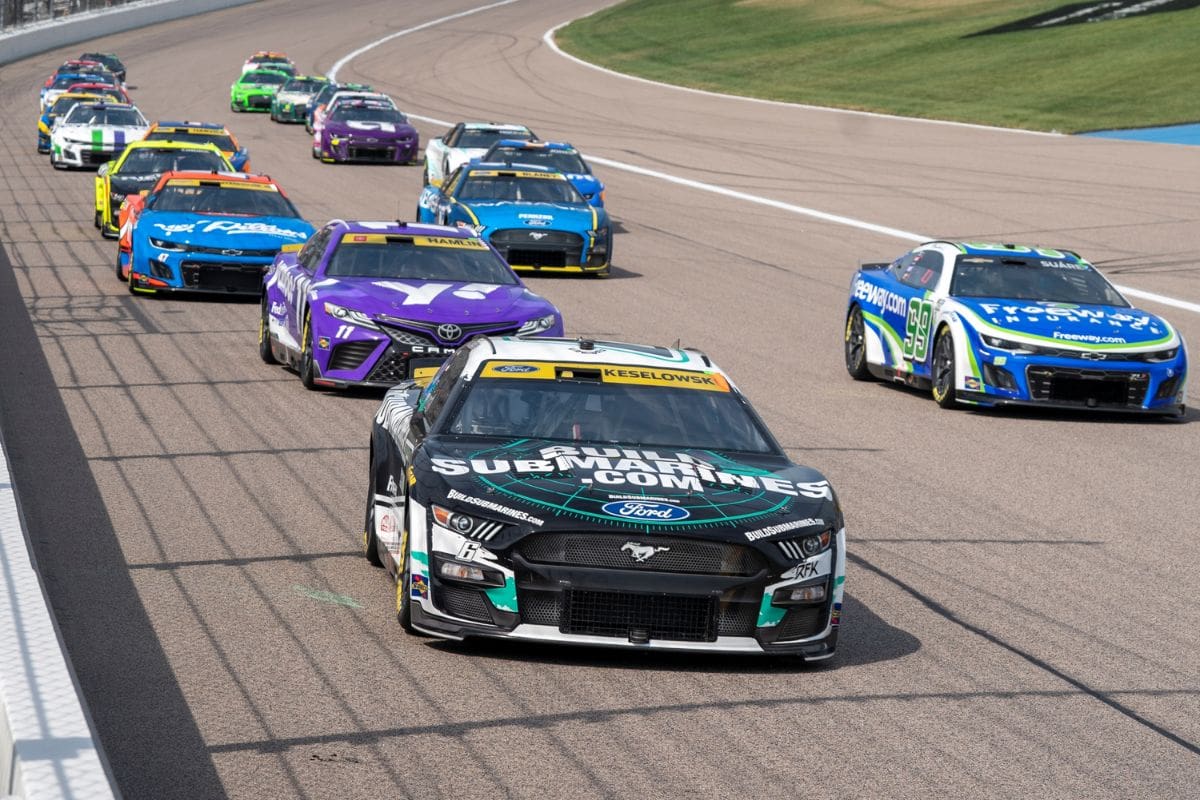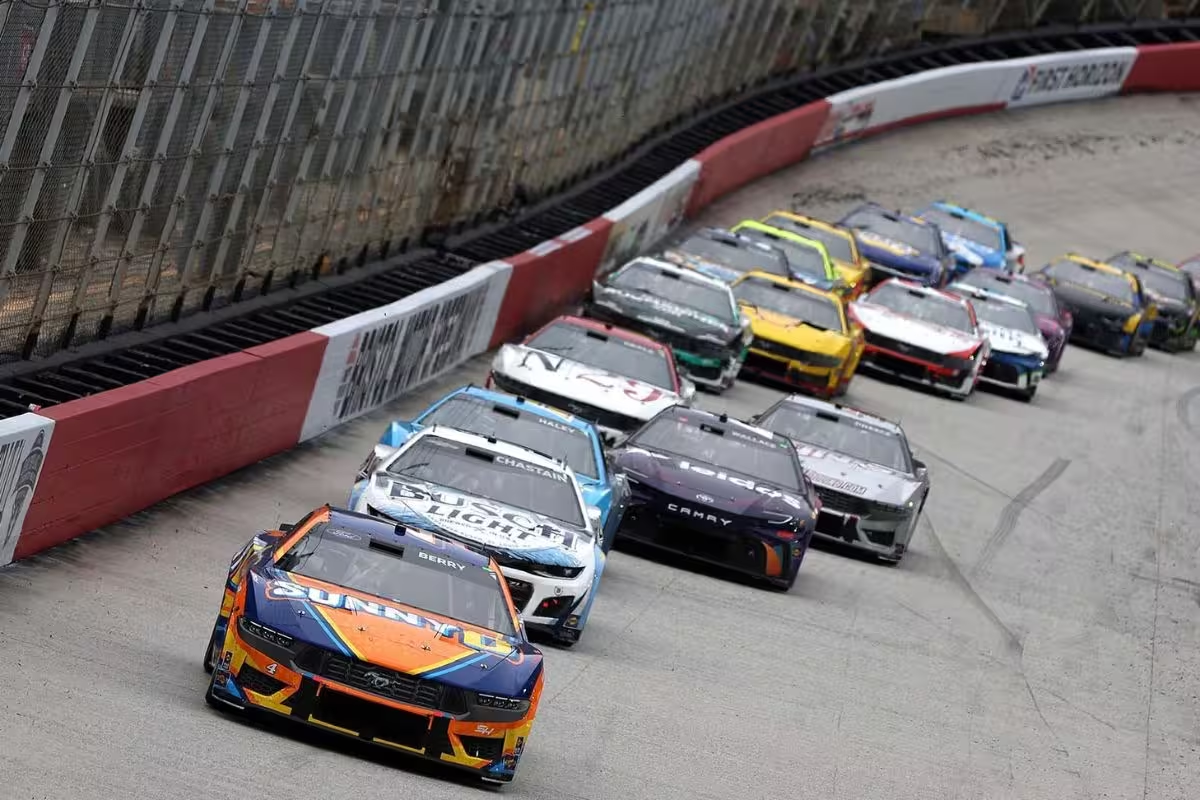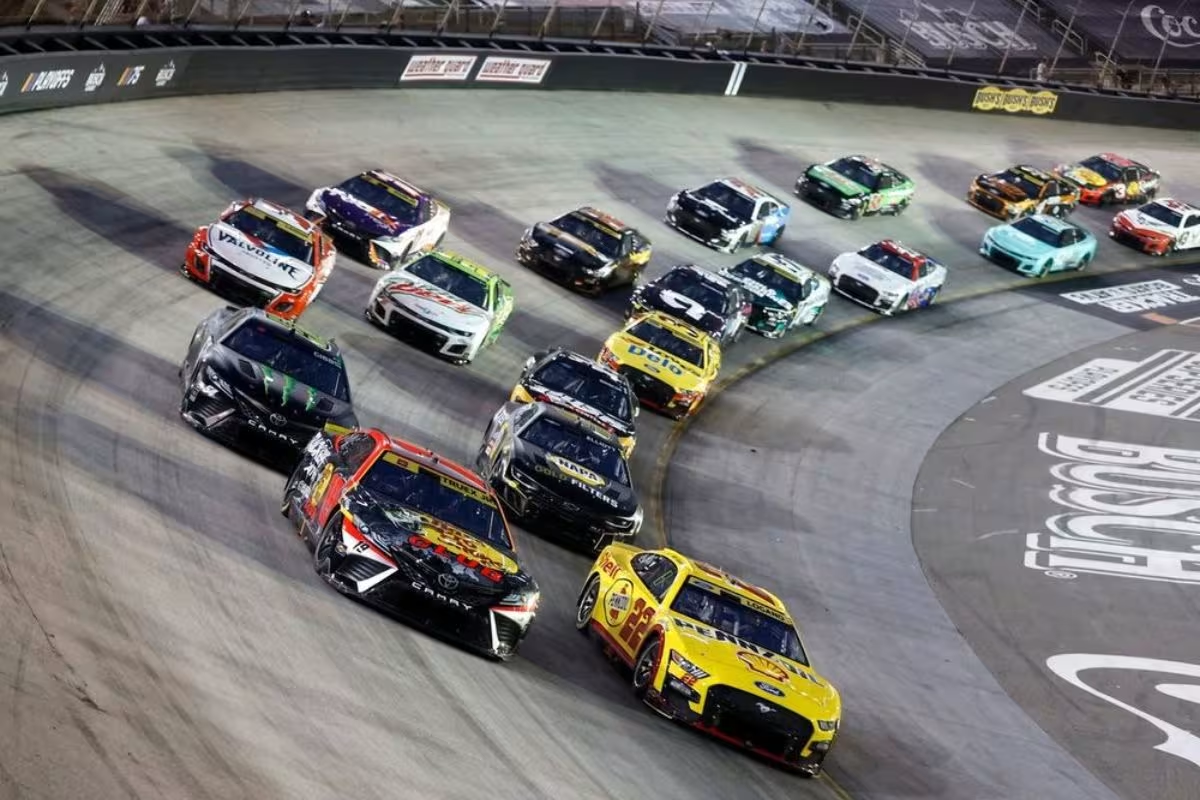NASCAR Struggling Teams at Kansas: As NASCAR teams gear up for the essential race at Kansas, a cloud of uncertainty hangs over the Cup Series, particularly for organizations such as 23XI Racing and Richard Childress Racing, who have struggled with consistency and performance. Meanwhile, stalwarts like Stewart-Haas Racing and Team Penske are grappling with their own reliability issues. This multifaceted challenge raises significant questions about the teams’ preparedness and tactical adaptability leading up to this essential event. What adjustments will these teams implement to turn their fortunes around, and how might these decisions impact the race dynamic?
Key Highlights
- Tyler Reddick’s lack of stage points and playoff performance jeopardizes his chances for success at Kansas.
- Todd Gilliland’s poor qualifying positions hinder Front Row Motorsports’ ability to compete effectively at Kansas.
- Denny Hamlin’s recent strong finishes contrast with Martin Truex Jr.’s decline, highlighting Joe Gibbs Racing’s need for tactical adjustments.
- Consistency issues plague Kaulig Racing, necessitating improved qualifying and pit strategies for better race outcomes at Kansas.
- RFK Racing’s historical struggles and recent performance issues indicate they must develop a solid strategy to capitalize on opportunities at Kansas.
23XI Racing
In the competitive landscape of NASCAR, XI Racing faces a crucial moment as Tyler Reddick navigates the playoffs. With the stakes heightened, Reddick’s performance has raised concerns, particularly in the context of stage points and total playoff scoring. Currently, he ranks worst among the remaining 12 playoff drivers in both categories, having secured only 11 stage points and a total of 69 playoff points. This underperformance not only jeopardizes his chances of advancing but also places considerable pressure on XI Racing as a whole.
The implications of Reddick’s struggles extend beyond the immediate metrics. In a sport where momentum can dictate outcomes, the inability to accumulate stage points can hinder Reddick’s tactical positioning on the track. Each stage serves as a critical juncture, providing opportunities for drivers to secure essential points and improve their playoff standings. Failing to capitalize on these opportunities may result in a snowball effect, diminishing both confidence and collective team morale.
Furthermore, the examination on XI Racing is likely to intensify as the playoffs progress. Teams are evaluated not only on their driver’s performance but also on their capacity to adapt and plan under pressure. Reddick’s current form necessitates a thorough analysis of both his driving techniques and the team’s comprehensive strategy.
23XI Racing must readjust its approach, ensuring that Reddick can optimize his potential in the remaining races. The path forward demands not just resolve but a cohesive strategy that utilizes every opportunity presented on the track.
Front Row Motorsports
The challenge of consistency looms large for Front Row Motorsports as they head into the Kansas race, particularly for driver Todd Gilliland. With a track record that reveals he has not started better than 25th in his five career Cup starts at this venue, the team faces a formidable task in enhancing their performance.
Kansas Speedway, known for its unique challenges, is an unforgiving landscape that demands both skill and tactics.
To navigate this important race effectively, several factors must be considered:
- Qualifying Performance: Securing a solid starting position is vital, and improving qualifying efforts will be necessary for Gilliland.
- Pit Strategy: Smart decisions during pit stops can greatly impact race outcomes, especially on a track where tire management is crucial.
- Adaptation to Track Conditions: Understanding how the car handles as the track evolves throughout the race will be essential.
- Consistent Communication: Continuous dialogue between the driver and crew can help in making real-time adjustments that might prove beneficial.
As Front Row Motorsports gears up for Kansas, the immediate focus must be on overcoming historical limitations.
The team’s ability to innovate and implement tactical adjustments will ultimately dictate their success.
With the right approach, they can transform past challenges into a stepping stone for future achievements, underscoring the important role of preparation in the high-stakes arena of NASCAR racing.
Hendrick Motorsports
Regularly a contender on the NASCAR circuit, Hendrick Motorsports enters the Kansas race with heightened expectations, particularly surrounding driver William Byron. With two top-10 finishes in the last eight races, Byron’s recent performance reflects a blend of potential and pressure as the team looks to secure a strong showing on this challenging track.
Byron’s ability to navigate the complexities of Kansas will be vital. The track’s unique layout demands not only speed but also tactical tire management and pit stop execution. With his team’s engineering skill and adaptability, they must take full advantage of Byron’s strengths, particularly in maintaining speed through corners.
Furthermore, Hendrick’s collective experience at Kansas showcases their potential to outperform competitors. The synergy between Byron and his crew chief will be critical, as they develop a race strategy that enhances both the car’s performance and Byron’s driving style. As they prepare for this race, the blend of expectation and opportunity could very well define Hendrick’s path in the playoffs.
Joe Gibbs Racing
As Hendrick Motorsports gears up for a strong performance at Kansas, Joe Gibbs Racing finds itself at a significant moment, grappling with recent inconsistencies despite having formidable talent behind the wheel. The team, known for its historic success, is under pressure to convert potential into results, especially with Kansas looming on the calendar.
Recent performance metrics raise concerns about their competitiveness:
- Denny Hamlin: Despite leading with 10 laps to go in the last two Kansas races, he has yet to secure a victory, finishing third in September 2023 and fifth in May. This trend of near-misses could weigh heavily on his confidence going into the race.
- Martin Truex Jr.: A troubling streak sees him finishing 20th or worse in the last eight races, which sharply contrasts his previous top-tier performances. This decline raises questions about the team’s tactical approach and overall vehicle performance.
- Ty Gibbs: The rookie has struggled, finishing no better than 15th in his last four outings. His development is vital for JGR, as his growth is integral to the team’s long-term plan.
- Team Dynamics: With a combination of veteran talent and emerging drivers, JGR must recalibrate to harness their full potential.
For Joe Gibbs Racing, the challenge lies not just in speed but in overcoming psychological barriers and refining tactics to translate talent into triumph. Their next opportunity at Kansas will be a significant test of their resolve and adaptability.
JTG Daugherty Racing
While JTG Daugherty Racing has shown flashes of potential, the team’s recent struggles have raised concerns about its competitiveness heading into the Kansas race. Ricky Stenhouse Jr., the team’s primary driver, has had a tumultuous season, marked by a troubling statistic: he has failed to finish five of the last eleven races due to accidents. Such a high rate of retirements not only hampers his momentum but also undermines the collective confidence within the team.
The incidents that have plagued Stenhouse Jr. stem from both on-track decisions and unfortunate circumstances, a combination that can be particularly demoralizing for a team aiming for consistency. As NASCAR’s competition intensifies, the ability to navigate through races without incident becomes increasingly vital. The Kansas race will present unique challenges, from the track’s abrasive surface to its multi-groove racing, demanding both skill and strategy.
For JTG Daugherty Racing to rebound, a thorough reassessment of their approach is crucial. This includes evaluating pit strategies, communication during races, and Stenhouse’s driving style under pressure. The team must also foster a culture of resilience, transforming setbacks into learning opportunities.
As they prepare for Kansas, the stakes are high for JTG Daugherty Racing. Success or failure in this race could greatly influence their path for the remainder of the season. With determination and a focus on execution, they have the potential to turn their fortunes around and showcase the talent that has previously ignited their performances.
Kaulig Racing
Kaulig Racing is endeavoring to turn the tide on a challenging season as they head into the Kansas race, where consistency has eluded them consequently. The team faces formidable hurdles, particularly exemplified by Daniel Hemric’s struggles, having started 30th or worse in 15 of the 29 races this season. This trend emphasizes the need for tactical adjustments as they seek to improve their competitive edge.
To navigate these challenges effectively, Kaulig Racing must focus on several important areas:
- Qualifying Performance: Improving starting positions is paramount. Consistently qualifying in the top 20 could fundamentally alter their race outcomes.
- Pit Strategy: A well-executed pit strategy can provide vital track position. The team needs to capitalize on every opportunity to gain an advantage during pit stops.
- Car Setup: Understanding the unique demands of Kansas is necessary. Data from previous races should inform adjustments, enhancing handling and speed.
- Driver Communication: Effective communication between the driver and crew chief can lead to better decision-making during the race, particularly in adapting to evolving track conditions.
As they prepare for Kansas, Kaulig Racing must harness these focus areas to cultivate a more robust performance.
With a commitment to refining their approach, they have the potential to shift momentum and secure a more favorable outcome in the remaining races of the season. The upcoming race presents an opportunity for resurgence—one that Kaulig Racing cannot afford to overlook.
Legacy Motor Club
Legacy Motor Club is facing a significant moment in the current NASCAR Cup season, particularly highlighted by John Hunter Nemechek‘s consistent struggles, as he has yet to secure a starting position better than 10th in any race this year. This trend raises important questions about the team’s overall performance and strategy heading into key races like Kansas.
Nemechek’s inability to break through the top ten in qualifying reflects deeper issues within the organization. It signifies not merely individual driver challenges but possibly systemic deficiencies in car setup, aerodynamics, or even pit strategy.
For a team attempting to establish itself among the competitive elite, these struggles could hinder their ability to capitalize on favorable track conditions and race strategies.
Moreover, as the NASCAR Cup series progresses, the significance of qualifying becomes magnified. Starting positions can greatly influence race outcomes, especially on tracks like Kansas, where track position is vital for success. The team must analyze data and performance metrics to identify the root causes of these issues.
The upcoming races present an opportunity for Legacy Motor Club to reassess its technical approaches and reinforce its operational strategies.
The development of a more competitive qualifying setup could serve as a catalyst for improved results, allowing Nemechek and his crew to gain momentum. A renewed focus on performance consistency will be fundamental, as the team seeks to navigate the challenges ahead and improve its standing in the NASCAR Cup landscape.
Richard Childress Racing
Frustration looms over Richard Childress Racing as the organization grapples with a series of disappointing performances, particularly from its star driver, Kyle Busch. The once-celebrated contender has struggled notably, raising concerns about both his and the team’s current path. Busch’s career-long winless streak has now reached an alarming 50 races, a statistic that highlights the urgency of the situation.
To contextualize the challenges faced by Richard Childress Racing, consider the following:
- Consistent Struggles: Busch has finished 25th or worse in two consecutive races, alongside a staggering 12 finishes of 25th or worse this season alone.
- Dillon’s Decline: Austin Dillon, who previously secured a victory at Richmond, has seen a disheartening trend with six consecutive finishes of 15th or worse.
- Competitive Landscape: The NASCAR Cup Series continues to evolve, with rival teams enhancing their performance, making victories increasingly elusive.
- Strategic Reevaluation: The organization may need to reassess its strategies, from car setups to pit strategies, to regain competitiveness on the track.
As the NASCAR Cup Series heads to Kansas, Richard Childress Racing finds itself at a pivotal juncture. Addressing these pressing issues will be paramount if the team hopes to turn around its fortunes and reclaim its position as a formidable contender in the sport.
The upcoming races will serve as a litmus test for the organization’s resilience and adaptability.
Rick Ware Racing
Rick Ware Racing faces considerable challenges as it prepares for the upcoming race at Kansas, highlighted by a troubling trend in qualifying performance. The organization has struggled greatly, with no car qualifying in the top 25 in eight of the last nine races. This lack of competitive qualifying speed not only limits their potential for race-day success but also raises questions about the team’s overall plan and execution.
The inability to secure a strong starting position places their drivers at a disadvantage, forcing them to navigate through a congested field from the outset. This challenge compounds the difficulty of capitalizing on race strategies, as starting further back often leads to battles with less experienced drivers or those who may not be on the same competitive level.
Consequently, the team must rethink its approach to qualifying sessions, focusing on refining setups and optimizing performance during practice to improve their chances of a better grid position.
Moreover, this trend could indicate deeper issues within the organization, including resource allocation, driver performance, and engineering capabilities. To rebound from this slump, Rick Ware Racing will need to utilize its experience and adapt swiftly.
This may involve tactical partnerships or improvements in technical support to strengthen their competitive edge. As they head into Kansas, the eyes of the NASCAR community will be keenly observing whether Rick Ware Racing can turn its fortunes around and reclaim a spot among the more competitive teams in the field.
RFK Racing
As the NASCAR Cup Series heads to Kansas, RFK Racing finds itself in a pivotal position, grappling with a series of challenges that have hindered their performance on track. With a storied history in the sport, the team now faces a formidable task as they endeavor to regain their competitive edge.
Several factors contribute to their current predicament:
- Historic Drought: RFK Racing’s last win at Kansas was in October 2012, a clear reminder of their struggles to find victory lane at this vital venue.
- Recent Performance: Brad Keselowski has not recorded a top 10 finish in the last four races, casting doubt on the team’s general speed and consistency.
- Near Misses: Drivers from RFK Racing have been passed for the win in the last two races on 1.5-mile tracks, illustrating a vulnerability in the closing laps.
- Kansas Woes: Chris Buescher’s recent finishes at Kansas reveal inconsistency, with four finishes of 15th or worse in the last five races, save for a near victory in May where he lost by just .001 seconds to Kyle Larson.
The upcoming race at Kansas will serve as a litmus test for RFK Racing.
The organization must utilize its historical knowledge and recent data to develop a strategy that not only addresses their shortcomings but also capitalizes on any opportunities presented during the race.
Success at Kansas is vital for the team’s confidence and momentum as they navigate the remainder of the season.
Spire Motorsports
Spire Motorsports enters the Kansas race with a mix of potential and pitfalls, particularly highlighted by Zane Smith’s struggle with pit road speeding penalties this season. Accumulating six penalties so far, Smith’s challenges on pit road underscore a significant area for improvement that could hinder the team’s overall performance.
The nuances of pit strategy and execution can often spell the difference between a solid finish and a disappointing result, especially on a track like Kansas, where track position is paramount.
The team’s performance metrics indicate that while Smith has shown flashes of competitiveness, the repeated penalties have marred his ability to take advantage of these opportunities. Each penalty not only costs valuable time but also diminishes the team’s tactical options as they navigate the race.
Consequently, a focus on precision during pit stops will be crucial for Spire Motorsports if they aim to utilize their car’s potential and improve their standing in the season.
Moreover, the team must analyze the root causes of these penalties. Whether it stems from miscommunication, equipment malfunctions, or driver inexperience, understanding the issue is fundamental for mitigating future occurrences.
As they approach Kansas, a concerted effort to refine their pit road discipline could be the key to revealing a more favorable race outcome. The stakes are high, and Spire Motorsports must harness both their potential and address their pitfalls to make the most of this critical race.
Stewart-Haas Racing
While Spire Motorsports grapples with challenges on pit road, Stewart-Haas Racing faces its own set of hurdles as they head into the Kansas race. The team, known for its competitive edge, is currently maneuvering a rough patch, particularly highlighted by Josh Berry’s recent performances. With ten finishes of 20th or worse in the last eleven races, the pressure mounts for the organization to regain its footing.
As Stewart-Haas Racing prepares for Kansas, several significant factors come into play:
- Driver Performance: Consistency is key, and Berry’s struggles raise concerns about the team’s overall competitiveness.
- Pit Strategy: Effective pit strategies will be vital to optimize track position and capitalize on opportunities.
- Car Setup: The right adjustments for Kansas’ unique track characteristics are important for maximizing speed and handling.
- Team Cohesion: A unified approach among crew members can lead to improved communication and execution during high-pressure moments.
The upcoming race at Kansas represents both a challenge and an opportunity for Stewart-Haas Racing. They must harness their collective experience and utilize data-driven insights to reverse the current trend.
With the right adjustments and a renewed focus, the team has the potential to turn their fortunes around. As the season progresses, fans and analysts alike will be watching closely to see if Stewart-Haas Racing can rise to the occasion and reclaim its status as a contender in the NASCAR Cup Series.
Team Penske
Heading into the Kansas race, Team Penske finds itself maneuvering a challenging landscape marked by inconsistent performances from its drivers. The current form of Austin Cindric and Joey Logano is particularly concerning, as both have recorded 13 finishes of 21st or worse this season, the highest among playoff contenders. This level of underperformance raises questions about the team’s general strategy and execution, especially at a significant moment in the season.
Ryan Blaney’s situation adds another layer of complexity. With three DNFs in the last five races, his reliability issues are alarming and indicative of a broader struggle within the team. Additionally, Blaney has managed just one top-10 finish in his last seven outings at Kansas, suggesting that this track may not play to his strengths. These troubling statistics highlight a trend that could severely hamper Team Penske’s playoff ambitions if not addressed.
As the team approaches this vital race, they must recalibrate their focus on consistency and reliability. The pressure mounts not only to secure solid finishes but also to improve their adaptability on the track.
With the stakes higher than ever, Team Penske’s ability to course-correct will be fundamental. The upcoming race at Kansas presents an opportunity to either reaffirm their status as championship contenders or further entrench them in a narrative of missed opportunities. How they respond to these challenges will be significant in shaping their postseason path.
Trackhouse Racing
As the NASCAR Cup Series turns its focus to Kansas, Trackhouse Racing aims to utilize its recent momentum to make a notable impact on the track.
With an evolving strategy and a competitive edge, the team is poised to harness its strengths as they prepare for the upcoming race. Daniel Suarez, a key driver for Trackhouse, holds a respectable record at Kansas, achieving two top 10 finishes in 15 Cup starts, indicating potential for further success.
To capitalize on their recent progress, Trackhouse Racing should consider the following strategies:
- Data-Driven Decisions: Analyze telemetry and performance metrics from past races to identify successful setups and best driving lines.
- Pit Strategy Enhancement: Collaborate with the pit crew to develop efficient pit stop strategies that can gain valuable track position during the race.
- Driver Communication: Maintain consistent and clear communication between Suarez and his crew, particularly regarding track conditions and adjustments needed during the race.
- Adaptability: Remain flexible and ready to adjust strategies as the race unfolds, particularly in response to changing weather and tire wear.
Wood Brothers Racing
Following the recent developments in the NASCAR Cup Series, Wood Brothers Racing finds itself in a challenging position as they head to Kansas. The team, known for its storied history and legacy in the sport, faces heightened examination after Harrison Burton‘s elimination from the playoffs following the race at Bristol. This setback not only affects the team’s momentum but also raises questions about their competitiveness as they approach the Kansas event.
Burton’s struggles at Kansas are particularly concerning; he has finished 30th or worse in four of his five Cup starts at this track. Such statistics underscore a troubling trend that could hinder the team’s performance this weekend. Kansas, with its unique surface and high-speed demands, has proven to be a formidable challenge for Burton. The team must dissect their prior efforts and identify the underlying issues contributing to these disappointing results.
For Wood Brothers Racing, the immediate focus must shift to maximizing their strategy and vehicle performance. Enhancing communication between the driver and crew chief, refining the car’s setup to better suit Kansas’s characteristics, and leveraging data analytics can provide critical advantages.
A successful turnaround at Kansas is crucial, not only for salvaging the season but also for reaffirming the team’s competitive spirit. As they navigate this pivotal race, the stakes are high; a strong performance could serve as a catalyst for growth and renewal for Wood Brothers Racing.
News in Brief: NASCAR Struggling Teams at Kansas
The challenges facing NASCAR teams as they approach the Kansas race underscore the necessity for tactical recalibration and improved communication. The underperformance of teams such as 23XI Racing and Richard Childress Racing, coupled with the inconsistencies evident in Stewart-Haas Racing and Team Penske, highlights the critical nature of adaptability in a competitive environment. Success in this pivotal race will depend on the ability of teams to identify weaknesses and exploit opportunities effectively, ultimately impacting their standings in the championship.
ALSO READ: NASCAR Round of 12 Qualified Drivers: Last 2 Names Will Surprise You!
